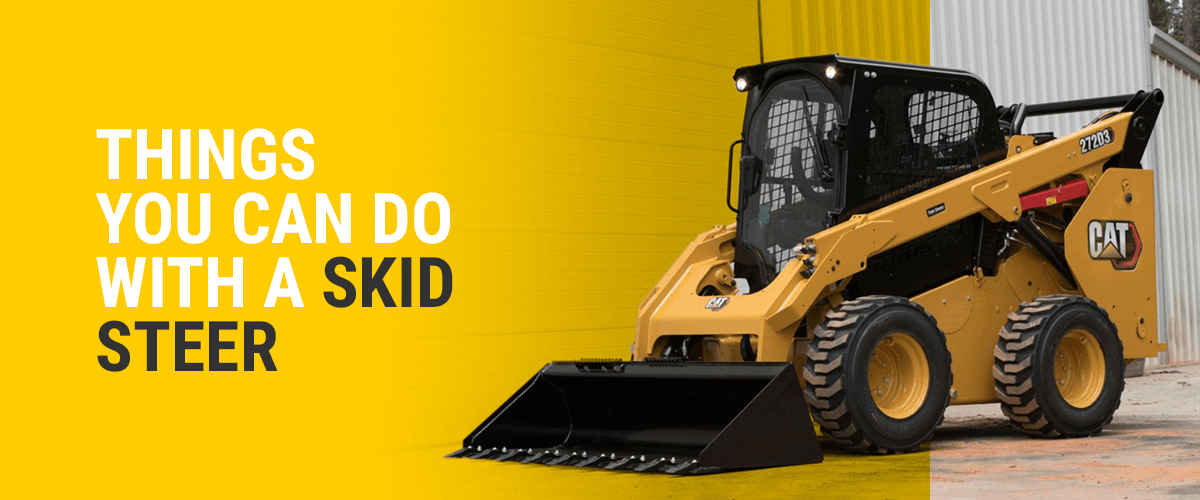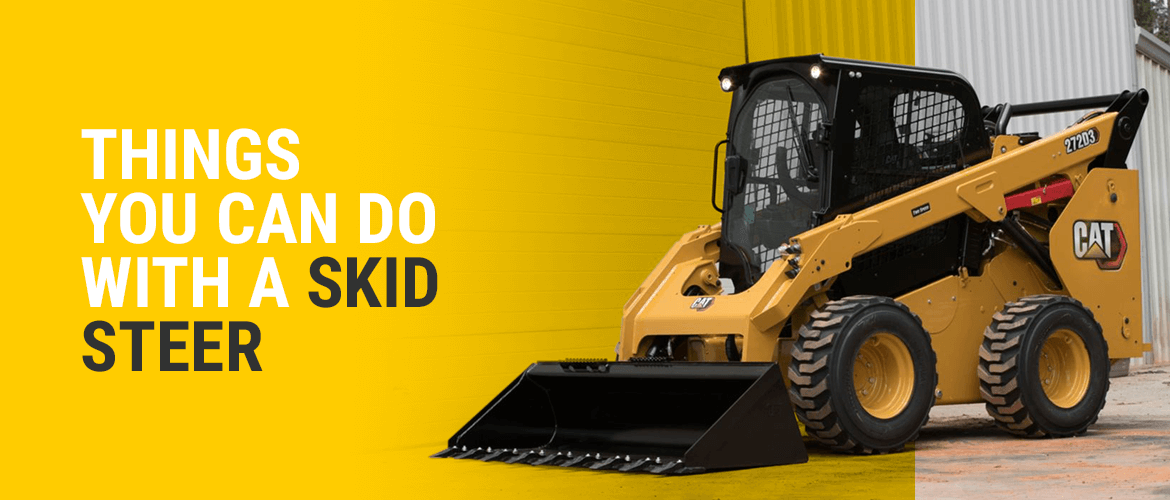Skid steers have become a popular choice in the construction and landscaping industries, but can they really replace other heavy equipment? Let’s find out! Whether you’re a curious construction enthusiast or just someone who loves learning about machines, this topic is sure to pique your interest. So, grab a seat and let’s dive into the world of skid steers and heavy equipment to discover if these versatile machines can truly live up to the challenge. Are you ready? Let’s get started!
When it comes to construction and earth-moving tasks, heavy equipment plays a vital role. From excavators and bulldozers to wheel loaders and backhoes, these robust machines have proven their worth on job sites worldwide. But lately, skid steers have been making waves in the industry. These compact and agile machines offer a range of attachments and can handle various tasks with ease. However, the question remains: can skid steers really replace their larger counterparts?
In this article, we’ll delve into the advantages and limitations of skid steers, comparing them to other heavy equipment. We’ll explore their capabilities, versatility, and maneuverability to determine if they can truly stand toe-to-toe with their bigger siblings. So, if you’re excited to learn more about skid steers and their potential to revolutionize the construction world, keep reading! By the end, you’ll have a clear understanding of whether skid steers can replace other heavy equipment or if they have their own unique place in the industry. Let’s roll!
Skid steers are versatile heavy equipment, but they can’t fully replace other machines. However, they excel in certain areas like maneuverability and compact size, making them ideal for construction sites with limited space. Skid steers can perform tasks such as excavation, grading, and lifting, but they may not have the power or reach of dedicated machines like excavators or cranes. It’s important to consider the specific needs of your project and consult with experts to determine the most suitable equipment.

Can Skid Steers Replace Other Heavy Equipment?
In the world of construction and heavy machinery, there has been an ongoing debate about whether skid steers can replace other types of heavy equipment. Skid steers are versatile machines that can handle a wide range of tasks, but can they truly replace bulldozers, excavators, and other heavy machinery? In this article, we will explore the capabilities of skid steers, compare them to other equipment, and discuss the benefits and limitations of using skid steers in various applications.
The Versatility of Skid Steers
Skid steers are compact machines that feature a small turning radius and excellent maneuverability. They are equipped with a bucket attachment at the front, which allows them to perform tasks such as digging, lifting, and pushing materials. However, skid steers can also be fitted with different attachments, such as forks, brooms, and augers, which significantly expand their capabilities.
This versatility is one of the main reasons why skid steers have become popular in the construction industry. They can efficiently perform a wide range of tasks, from landscaping and material handling to demolition and snow removal. Skid steers are also used in agriculture, forestry, and even in urban environments for maintenance and cleaning tasks.
The compact nature of skid steers allows them to access confined spaces and work in tight areas where larger equipment may struggle. This makes them ideal for jobs in urban environments, where space is limited and precision is required. Skid steers are also popular in residential construction projects, as they can navigate through narrow pathways and operate in backyard spaces.
The Advantages of Skid Steers
Skid steers offer several advantages over traditional heavy equipment. One of the key advantages is their maneuverability. Their small size and tight turning radius enable operators to easily navigate around obstacles, reducing the need for additional equipment or manual labor. Skid steers can quickly change direction and make sharp turns, making them highly efficient in confined work areas.
Another advantage of skid steers is their versatility in terms of attachments. By simply swapping out the bucket attachment, skid steers can be transformed into machines capable of performing various tasks. This eliminates the need for multiple pieces of specialized equipment, saving both time and money. Additionally, the quick attachment change system allows operators to switch between attachments rapidly, increasing productivity on the job site.
In terms of cost, skid steers are often more affordable than larger heavy machinery. They have a lower initial purchase price and require less maintenance and fuel compared to larger equipment. Skid steers also have a smaller footprint, which means they require less storage space and can be transported more easily.
The Limitations of Skid Steers
While skid steers offer many benefits, they also have some limitations. One of the primary limitations is their operating capacity. Skid steers have a lower lifting and digging capacity compared to larger equipment such as excavators or bulldozers. This makes them less suitable for heavy-duty tasks that require significant power and strength.
Skid steers also have a lower ground clearance compared to other heavy equipment. This can limit their ability to navigate through rough terrains or uneven surfaces. Additionally, the smaller size of skid steers means they may not be able to cover large areas as quickly as larger equipment, which can affect overall productivity on larger projects.
Another limitation of skid steers is their stability. Due to their compact design and high center of gravity, skid steers can be prone to tipping over, especially when operating on uneven terrain or slopes. Proper training and adherence to safety guidelines are crucial when operating skid steers to mitigate this risk.
Conclusion
Skid steers are incredibly versatile and can perform a wide range of tasks in various industries. While they may not completely replace other types of heavy equipment, they offer unique advantages that make them valuable additions to any job site. Their maneuverability, versatility in attachments, and cost-effectiveness make them an attractive choice for many construction and maintenance projects. It is important to assess the specific requirements of a job and consider factors such as lifting capacity, terrain, and productivity to determine whether a skid steer is the right choice or if additional equipment is necessary.
Key Takeaways: Can Skid Steers Replace Other Heavy Equipment?
- Skid steers are versatile machines that can perform a wide range of tasks.
- They are compact and maneuverable, making them ideal for small and tight spaces.
- Skid steers can replace certain heavy equipment like excavators and loaders in some situations.
- However, skid steers have limitations in terms of lifting capacity and reach compared to specialized heavy equipment.
- It’s essential to consider the specific job requirements and limitations of skid steers before deciding to replace other heavy equipment.
Frequently Asked Questions
Skid steers are versatile machines used in various industries. Here are answers to commonly asked questions about whether skid steers can replace other heavy equipment.
1. Are skid steers capable of performing the same tasks as excavators?
While skid steers and excavators share some similarities, they have different strengths. Skid steers are excellent for tasks that require maneuverability and agility, such as loading and unloading materials, grading, or landscaping. Excavators, on the other hand, excel at digging, trenching, and heavy lifting.
Although skid steers can be equipped with attachments that mimic some excavator functions, such as digging buckets, they are not designed to replace excavators entirely. The choice between a skid steer and an excavator depends on the specific job requirements and the efficiency of each machine in accomplishing those tasks.
2. Can skid steers take the place of a traditional wheel loader?
Skid steers and wheel loaders have different capabilities and are used for distinct purposes. Skid steers are more compact and agile, making them suitable for tight spaces and smaller construction sites. They are ideal for tasks like material handling, snow removal, and landscaping.
On the other hand, wheel loaders are designed for heavy-duty tasks that require high lifting capacities and a larger bucket capacity. They are commonly used in construction sites, mining operations, and other heavy industry applications. While skid steers can handle lighter loads, they may not have the lifting capacity required for certain wheel loader tasks.
3. Are skid steers a viable alternative to bulldozers?
Skid steers and bulldozers have different purposes and capabilities. Bulldozers are primarily used for heavy-duty earthmoving and leveling large areas of land. They are equipped with a large blade that is ideal for pushing, grading, and leveling soil and other materials.
Skid steers, on the other hand, are more versatile and can be used for a wide range of tasks, including grading, landscaping, and site preparation. However, their smaller size and lower horsepower may limit their effectiveness when compared to bulldozers for heavy-duty earthmoving tasks.
4. Can skid steers replace forklifts in material handling operations?
Skid steers can be equipped with forklift attachments, making them capable of performing some material handling tasks. However, forklifts are specifically designed for efficient and safe movement of heavy pallets and loads in warehouse and industrial settings.
Forklifts have features such as extended forks, increased lifting capacities, and better load stability. They are designed to handle heavy loads with precision and stability, which makes them more suitable for material handling operations compared to skid steers. While skid steers can supplement forklifts in certain situations, they may not entirely replace them in material handling applications.
5. Can skid steers fulfill the same roles as compact track loaders?
Skid steers and compact track loaders are similar in many ways, but they have distinct differences that make them suited to different applications. Skid steers are equipped with tires, making them ideal for use on hard surfaces like concrete or asphalt. They are commonly used in construction, landscaping, and snow removal.
Compact track loaders, on the other hand, are fitted with tracks instead of tires, which provides them with enhanced traction and flotation. This makes them better suited for working in soft, muddy, or uneven terrain. They are commonly used in agriculture, forestry, and landscaping applications where ground conditions can be challenging. While there may be some overlap in their capabilities, skid steers and compact track loaders are designed to fulfill different roles.
Replace Skid Steer Tracks WITHOUT Using Other Heavy Equipment – Track Replacement In The Field
Summary
So, can skid steers replace other heavy equipment? Well, it depends on the job. Skid steers are versatile and can handle a wide range of tasks, but they may not be suitable for every situation. They’re great for smaller projects and tight spaces, but larger jobs might still require specialized heavy equipment. Skid steers can do a lot, but they can’t do it all.
That being said, skid steers offer many advantages. They’re compact, maneuverable, and easy to operate. They can be equipped with different attachments for various tasks, like digging, lifting, and grading. This versatility makes them a popular choice for landscaping, construction, and agriculture. So, while skid steers might not replace all heavy equipment, they certainly have a valuable place in the industry.

